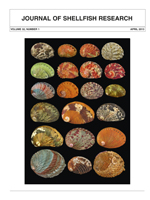Historically, Point Loma had the highest fishery landings of pink abalone (Haliotis corrugata Wood 1828) along the California coast. The current status of the population in this key location is described using population and aggregation surveys from 2004 to 2007. We developed a size-based matrix model to assess the recovery potential of this low-density population. We incorporated fecundity parameters into the model, modified by empirical nearest-neighbor distance, aggregation size, sex ratio, and size-frequency data, to evaluate their influence on the population growth rate. We found the density of the population (∼170 abalone/ha) is an order of magnitude less than the minimum spawning density (2,000 abalone/ha) used by the California Department of Fish and Wildlife for abalone management. The average aggregation size was ∼2 abalone, and more than 50% of the abalone were solitary (no neighbors within a 2.5-m distance). The average nearest-neighbor distance was greater than 5 m in all 3 y, corresponding to an estimated fertilization success rate of ∼20%. The per capita recruitment potential was 1.3–5.3 recruits per female in 2006 and 2007. Population growth rates (λ) from the models including aggregation characteristics were 12%–18% less than the models with no aggregation information. A further 12% reduction in λ occurred between models assuming high and low fertilization success (high, 1.04/y; low, 0.91/y), showing that inclusion of aggregation characteristics has a large impact on population viability analyses. Under the International Union for the Conservation of Nature threat categories, a population with a λ of 0.91 would be classified as endangered. Based on these results, we define recovery targets for pink abalone as (1) aggregation size ≥ 5 abalone and (2) nearest-neighbor distance less than 1.6 m. We suggest aggregation characteristics will be important to include when quantifying recovery goals for depleted populations of species susceptible to reproductive Allee effects.
How to translate text using browser tools
1 April 2013
Assessing the Recovery of Pink Abalone (Haliotis corrugata) by Incorporating Aggregation into a Matrix Model
Cynthia A. Catton,
Laura Rogers-Bennett
ACCESS THE FULL ARTICLE

Journal of Shellfish Research
Vol. 32 • No. 1
April 2013
Vol. 32 • No. 1
April 2013
Allee effects
conservation actions
Haliotis corrugata
nearest-neighbor distance
pink abalone
population viability analysis
restoration targets




